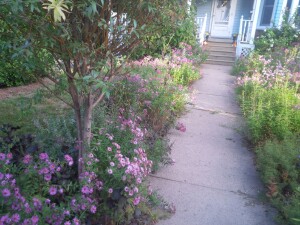 I once had an elderly babysitter who lived a Spartan life and indulged in only one vice—one scoop of vanilla ice cream once a week. This may have accounted for the fact that she lived in permanent disapproval mode. Once, when I was about twelve I greeted her arrival wearing what I thought was a fashionably short skirt. She managed to unpurse her lips long enough to spit out the words, “I have never seen an attractive knee.”
I once had an elderly babysitter who lived a Spartan life and indulged in only one vice—one scoop of vanilla ice cream once a week. This may have accounted for the fact that she lived in permanent disapproval mode. Once, when I was about twelve I greeted her arrival wearing what I thought was a fashionably short skirt. She managed to unpurse her lips long enough to spit out the words, “I have never seen an attractive knee.”
I thought of this earlier this week when I looked out at the sea of tall New England-type asters in my front garden. They are a vision in shades of pink and purple-pink, resembling an Impressionist painting, especially in the golden light of late afternoon. I love them, and though they have no knees, I have to admit, they have ugly legs.
I have done what I could about that, giving them the “Chelsea chop” back in May and July to keep them from growing to five or six feet. The deer have helped that effort, regularly cropping the plants. But no matter how tall or short the asters grow, they still rise on spindly brownish stalks accented by slender leaves that do little to diminish the awkward effect.
Tall asters are not the only plants that have ugly legs. Hollyhocks, those late summer stalwarts, rise tall and handsome on thick, slightly hairy stalks that seem at odds with the gorgeous blooms at the tops. Hollyhock leaves tend to be large, medium green and lobed, but they are frequently plagued by rust, a fungal malady that eliminates any vestige of attractiveness.
Some of the taller zinnias have a similar problem, with stems at odds with the beauty of the flowers. They can fall prey to powdery mildew, which will not harm the plants, but does a number on the appearance of leaves and stems.
Truth be told, a good many of my beloved roses also have less than desirable “legs”.
My childhood babysitter used to cover her self-described ugly knees with midi-skirts. You can do the same job in the garden by positioning shorter plants, preferably with lush, mounding habits, in front of your leggier specimens. Tall asters, for example, are nicely complemented by shorter asters, which will bloom at the same time. If you let your New England asters reach maximum height, you can site the beautiful Frikart’s aster or Aster frikartii ‘Monch’, in front of them. Frikart’s aster transforms itself into a sky-blue froth in September, billowing forth. It is gorgeous in its own right, but makes a good “leg” camouflage as well. The ‘Woods’ series of asters, blessed with a mounding habit, and available in pink, several shades of blue and white, are another good cover, rising only 12 to 18 inches tall.
You can also remedy the leg problem by using mums, either the “hardy” varieties available now in garden centers, or the so-called garden mums, which are reliably perennial. Both mound nicely and bloom right along with the asters. Potted “hardy” moms can be plopped right down in front of the tall asters and removed once the fall bloom season is over.
For statuesque hollyhocks, giant leggy zinnias and roses, I am partial to plants that provide good coverage with little fuss. Roses and lavender are natural companions, with the lavender providing some critter protection for the roses in addition to camouflage for less-attractive canes. I especially like the new lavender ‘Phenomenal’, which is extraordinarily floriferous and seems hardier than some of the older varieties.
If lavender never quit succeeds in your garden, try catmint or Nepeta. It is hardy, resistant to four-legged garden pests, aromatic and able to cover itself with blue-purple blooms even in drought season. Covering the ugly “legs” of any taller plant is easy work for these garden “cats”.
Disguising tall aster stalks with more asters is a trick that you can duplicate with taller and shorter zinnia varieties as well. Smaller varieties, like ‘White Star’, that grow only a foot tall, make great companions for the ‘California Giant’ types that rise much higher. The best part of the combination is that both tall and short zinnias are excellent “cut and come again” flowers that keep producing blooms as long as you pick them or remove the faded flowerheads.
Next year I am going to take more trouble to camouflage my tall asters’ less than stellar “legs”. My old babysitter would surely approve.
